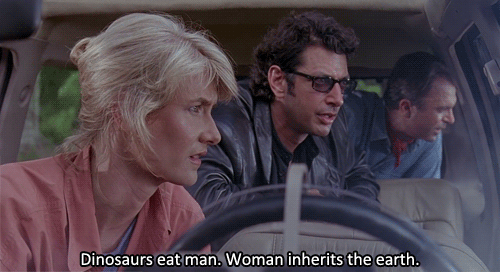Lanas-own-blog - My Personal Space.

More Posts from Lanas-own-blog and Others


NASA Astronomy Picture of the Day 2015 September 17
Pickering’s Triangle in the Veil
Chaotic in appearance, these filaments of shocked, glowing gas break across planet Earth’s sky toward the constellation of Cygnus, as part of the Veil Nebula. The Veil Nebula itself is a large supernova remnant, an expanding cloud born of the death explosion of a massive star. Light from the original supernova explosion likely reached Earth over 5,000 years ago. Blasted out in the cataclysmic event, the interstellar shock waves plow through space sweeping up and exciting interstellar material. The glowing filaments are really more like long ripples in a sheet seen almost edge on, remarkably well separated into the glow of ionized hydrogen and sulfur atoms shown in red and green, and oxygen in blue hues. Also known as the Cygnus Loop, the Veil Nebula now spans nearly 3 degrees or about 6 times the diameter of the full Moon. While that translates to over 70 light-years at its estimated distance of 1,500 light-years, this field of view spans less than one third that distance. Identified as Pickering’s Triangle for a director of Harvard College Observatory and cataloged as NGC 6979, the complex of filaments might be more appropriately known as Williamina Fleming’s Triangular Wisp.
Yesss Finnish power! J-P Metsävainio is one of my favourite astrophotographers, and I’m weirdly proud to be a Finn every time he gets his work on APOD.

Pickering’s Triangle






An Adaptable Species: Part 2 of 4 (Part 1) Episode 11: The Immortals, Cosmos: A SpaceTime Odyssey
















An Adaptable Species: Part 1 of 4 Episode 11: The Immortals, Cosmos: A SpaceTime Odyssey
me @ myself: get it together.....
also me @ myself: ur literally going through a lot rn? cut yourself some slack?
also also me @ myself: ...anyway....i hate my entire self










How to stabilize a wobbly table?
You are in a restaurant and you find that your table wobbles. What do you do? Most people either put up with it, or they attempt to correct the problem by pushing a folded table napkin under one of the legs. But mathematicians can go one better. A couple of years ago, four mathematicians published a research paper in which they proved that if you rotate the table about its center, you will always find an orientation where the table is perfectly stable.
This problem - as a math problem - has been around since the 1960s, when a British mathematician called Roger Fenn first formulated it. In 1973, the famous math columnist Martin Gardner wrote about the problem in his Scientific American column, presenting a short, clever, intuitive argument to show how rotation will always stop the wobble. Here is that argument.
This only works for a table with equal legs, where the wobble is caused by an uneven floor. However uneven the floor, a table will always rest on at least three legs, even if one leg is in the air. Suppose the four corners are labeled A, B, C, D going clockwise round the table, and that leg A is in the air. If the floor were made of, say, sand, and you were to push down on legs A and B, leaving C and D fixed, then you could bring A into contact with the floor, but leg B would now extend into the sand. Okay so far?
Here comes the clever part. Since all four legs are equal, instead of pushing down on one side of the table, you could rotate the table clockwise through 90 degrees, keeping legs B, C and D flat on the ground, so that it ends up in the same position as when you pushed it down, except it would now be leg A that is pushed into the sand and legs B, C, and D are all resting on the floor. Since leg A begins in the air and ends up beneath the surface, while legs B, C, and D remain flat on the floor, at some point in the rotation leg A must have first come into contact with the ground. When it does, you have eliminated the wobble.The result follows from the Intermediate Value Theorem (Proof).
For more - VIDEO: Fix a Wobbly Table (with Math) by Numberphile.
Consider an interval I = [a, b] in the real numbers ℝ and a continuous function f : I → ℝ. Then, Version I. if u is a number between f(a) and f(b), f(a) < u < f(b) (or f(a) > u > f(b) ), then there is a c ∈ (a, b) such that f(c) = u.

This argument seems convincing, but making it mathematically precise turned out to be fairly hard. In fact, it took over 30 years to figure it out. The solution, presented in the paper Mathematical Table Turning Revisited, by Bill Baritompa, Rainer Loewen, Burkard Polster, and Marty Ross, is available online at Mathematical table turning revisited 19, Nov 2005, http://Arxiv.org/abs/math/0511490
The result follows from the Intermediate Value Theorem. But getting it to work proved much harder than some other equally cute, real-world applications of the IVT, such as the fact that at any moment in time, there is always at least one location on the earth’s surface where the temperature is exactly the same as at the location diametrically opposite on the other side of the globe. As the authors of the 2005 solution paper observe, “for arbitrary continuous ground functions, it appears just about impossible to turn [the] intuitive argument into a rigorous proof. In particular, it seems very difficult to suitably model the rotating action, so that the vertical distance of the hovering vertices depends continuously upon the rotation angle, and such that we can always be sure to finish in the end position.” The new proof works provided the ground never tilts more than 35 degrees. (If it did, your wine glass would probably fall over and the pasta would slide off your plate, so in practice this is not much of a limitation.) Is the theorem any use? Or is it one of those cases where the result might be unimportant but the math used to solve it has other, important applications?…… “I have to say that, other than the importance of the IVT itself, I can’t see any application other than fixing wobbly tables. Though I guess it does demonstrate that mathematicians do know their tables”- Mathematician Keith Devlin.
[SOURCE - MAA.org, K. Devlin, Feb. 2007]
[PDF] On the stability of four legged tables, A. Martin, 15 Aug. 2006: Proving that a perfect square table with four legs , place on continuous irregular ground with a local slope of at most 14.4 degrees and later 35 degrees, can be put into equilibrium on the ground by a “rotation” of less than 90 degrees. And Discussing the case of non-square tables and make the conjecture that equilibrium can be found if the four feet lie on a circle.
Also, I think we can add an actual argument: “The table would be stability (not wobble) if their four legs contact the ground - not necessarily that they have lie on the same flat surface ”, then everything will be easier to approach the problem that the authors wrote.

I've had lots of blogs in the past, but this one I'm actualy excited to share with people.
68 posts


